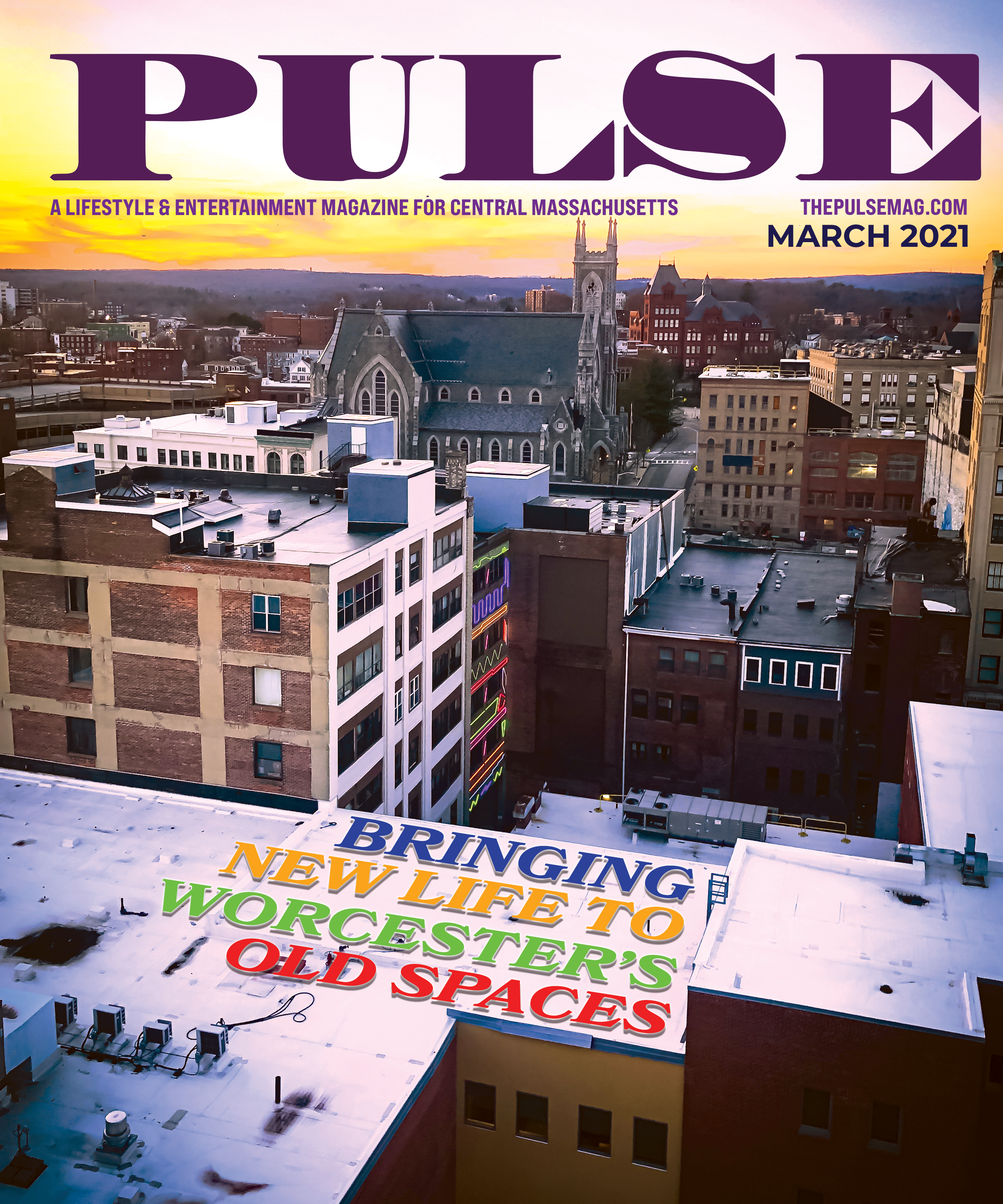
Jennifer Russo
First settled by the Nipmuc tribe, and then by the English who settled in 1674, Worcester is rich in history. In the 1800’s the city became a manufacturing and transportation hub with a new railroad, attracting immigrants from European countries looking for work. It became the center of machinery and construction and was a booming business area for some time. After some decline after the two World Wars, it picked back up again in the mid 1900’s with the building of two large hospitals, biomedical buildings, Route 290 and some of the area’s top colleges and universities.
Fast forward to today. Investors and visionaries have been collaborating to renew the area and breathe into it a new life, realizing the true potential of the city. Renovations of Hanover Theater, Saint Vincent Hospital and Union Station in recent years, and newer structures like the convention center and Assumption’s new academic buildings. Many designers are looking at modernizing buildings that will change the architectural face of the city and provide more opportunity for an enhanced lifestyle, while still maintaining its historic charm.
Vincent Pacifico, photo by Antoinette Pacifico
Vincent Pacifico – Turning Great Passion into Great Ideas
Vincent Pacifico believes that historic buildings only add to the aesthetic of our New England towns and cities, but that doesn’t mean they can’t be rehabilitated for a more modern use. For Vincent, love of architecture and design began with building and carpentry. Being very into skateboarding when he was young and creating his own ramps to skate on sparked something in him. After a neighbor suggested he look into the architecture field, that spark turned into a flame. He later went to Roger Williams School of Architecture in Rhode Island, getting his Masters degree in the discipline. His graduate thesis included a reuse design for the vacant Goldstein Scrap Metal building located on Harding Street, down in the Canal district.
The vacant Goldstein building on Harding St Pacifico’s proposed exterior rendering
Pacifico’s proposed interior rendering (upper floor)
“I started to be very passionate about solving the complex problem of what to do with all of our vacant industrial buildings from the manufacturing days. We live in an area where our cities and towns are full of vacant and abandoned brownfield industrial sites with no current use and have since become dangerous structures prone to fires. Likewise, the areas are more prone to crime because there are no eyes on the street watching over our neighborhoods. This avenue of architecture is something that I decided I wanted to go down and tackle, living in the heart of it in New England,” says Vincent.
With this as a major driver for him personally, Pacifico also believes strongly in networking of like-minded individuals. In 2019, he founded the Adaptive Buildings Network, a social space for designers, architects, city planners and urban advocates to come together and share ideas on urban redevelopment and adaptive reuse. He hosted his first event in November of that year, presenting his thesis project. He hopes to continue events like this once we can gather as groups, bringing in guest speakers to present reuse project ideas to inspire the designer community and so that Worcester area designers can build meaningful connections.
In addition to his passion for repurposing historic commercial buildings, Vincent and his business partner Peter Fauci started a small design practice called Pacific-Visions Studio LLC. The business focuses on small residential design, but specifically the rehabilitation and renovation of single-family homes in the Central Massachusetts region down into Rhode Island. One of their current projects is an extensive renovation of a home in the Grafton Hill neighborhood. The business believes strongly in the sustainability that renovation brings.
“It is often said that the greenest building is the building that is already built,” shares Vincent. “Just like my ideas on urban adaptive reuse and saving and repurposing industrial buildings, homes need to be repurposed and reconfigured for 21st century living conditions. I believe it’s better to reuse a building the best you can instead of completely demolishing it and adding it to the landfill – our buildings have so much embodied energy already in them, it’s better to reuse them.”
Grafton Hill existing home Grafton Hill renovation rendering
Being from the area, Vincent sees enormous potential in Worcester, calling it a “new frontier that has amazing existing building stock, transportation lines, and booming industries that are still very alive in the city” and determining that “it is just the start of its Renaissance.” He has an idea for a potential project that he knows would be amazing, repurposing a vacant site in the city into a mixed-use development hosting commercial boutique stores geared toward small business, office space for start ups trying to have success in the city, and affordable housing options.
“I like to reference back to the teachings of Jane Jacobs and the ideas that the city is a place for all people to live, enjoy and work in,” says Vincent. “It shouldn’t just be for the upper class but a place where everyone can contribute and that they can take part in.”
Vincent, with all his big ideas and dreams, does one day hope to open a small design office in Worcester and contribute to the community through the lens of architecture.
Courthouse Postcard Photo A rendering of a living space at Courthouse Lofts (courtesy of Trinity)
The Old County Courthouse Turned Luxury Living
Back in 1845, the Greek Revival style county courthouse was built, with a series of additions and renovations in the later part of the century. Back in 1897, there was even a competition run to craft a redesign of the building, with the criteria of keeping the front columns as part of the design, with the winning entry being worked into the next renovation.
Because the building no longer suited the needs of the growing city, all court proceedings and activities moved in 2007. Since then, the building had gone up for auction and ultimately ended up being purchased by the city itself, where it lay dormant for years. In 2017, Trinity Financial purchased the building and hired out The Architectural Team (TET), a firm which has experience in working on historic structures, to begin work on the new Courthouse Lofts complex. The new structure is a modern residential building boasting expertly designed spaces, from studios to three-bedroom apartment units.
“The original building was incredibly important to the history of Worcester, so it was critical to find a way to reuse it and bring life back to it and the northern part of Main Street” says Michael Lozano of Trinity Financial.
“It was a complicated and challenging project, but clearly worth the effort. We kept as many original details as we could (like jury boxes, for example), which really contributes to the uniqueness and coolness factor of our new living spaces.” he shared. “There’s nothing around like it, and every single unit in the building has something cool and different about it, offering soaring ceilings, huge windows, custom kitchens, in-unit washers and dryers and lots of quirky and cool details.”
Courthouse Lofts are now offering tours and accepting applications for residence – learn more at courthouselofts.net
Daniel Benoit, Benoit Design Group
Dan Benoit – Bringing Worcester Forward with a Creative Edge
On a lot of land on Grafton Street near Union Station, once stood the Osgood Bradley building, a former rail car manufacturer. Today, a very different kind of building takes up the square footage.
The Edge at Union Station was designed, working alongside building manager Vision Development, by architect Dan Benoit, and houses over 200 students off campus. It is an upscale approach to design and gives a sense of the modern comfort you may find in a starred hotel, complete with common areas for lounging, studying, fitness and even playing some old-fashioned arcade or a game of pool.
The Osgood Bradley Building The Edge at Union Station
One of the Lounge Spaces at Edge
With all its modern conveniences, there are still elements of history that reveal themselves in the design, like exposed brick or other original parts of the structure.
“For historic projects, I look at the story the building has to tell about what it was used for in the past or the significance of the products they produced on the overall history of the city. Also, how the building relates to the site or the evolution of the site over the years,” Dan shares. “Those old elements are what usually give you the character of the building, so we try to save them whenever possible. Sometimes things could be beyond repair though, so we might have to reinterpret that particular detail.”
The Printers Building
Dan also worked on the Printer’s Building located on Portland St, an almost 100-year old building which once housed two printing companies, and is now used for several different businesses today, including a well-loved art gallery and WICN radio.
WICN Lobby Art Gallery
Dan is currently working on what he says is his favorite project so far, a mixed-use facility at the Table Talk site in Kelley Square. Since Table Talk has moved on to another location, Dan says the building offers a great “opportunity to redefine a significant urban area that can contribute to the continued revitalization of the city.”
Dan tells us that his journey into architecture began with being exposed to blueprints of houses as a child. With a father who was an electrical contractor, these were easy to come by, and Dan loved to look at them and try to design his own houses. He also loved building models. Some things were just meant to be. Now, having lived in Worcester most of his adult life, he has a strong sense of purpose to keep the city moving forward.
“I believe that this city has great architectural bones and proud residence, and with perseverance this city could reinvent itself for the next generation,” he says.
We couldn’t agree more.






